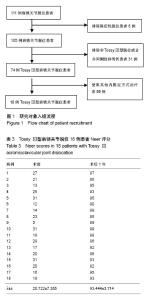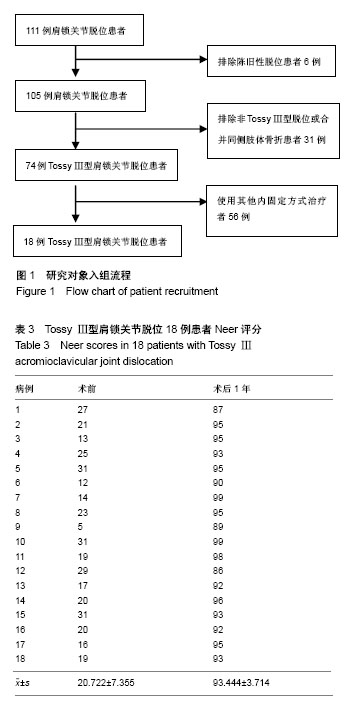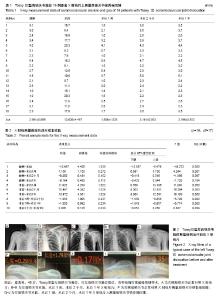| [1] Babhulkar A, Pawaskar A. Acromioclavicular joint dislocations. Curr Rev Musculoskelet Med. 2014;7(1):33-39.[2] Acdonlad P,Sunner P,Dyck M. A follow- up of surgical treatment of type Ⅲ AC dislocations. Paper presented at the closed ASES meeting, 2006.[3] Takase K, Yamamoto K. Changes in surgical procedures for acromioclavicular joint dislocation over the past 30 years. Orthopedics. 2013;36(10):e1277-1282.[4] Johansen JA, Grutter PW, McFarland EG, et al. Acromioclavicular joint injuries: indications for treatment and treatment options. J Shoulder Elbow Surg. 2011;20(2 Suppl): S70-82.[5] Babhulkar A, Pawaskar A. Acromioclavicular joint dislocations. Curr Rev Musculoskelet Med. 2014;7(1):33-39.[6] Takase K, Yamamoto K. Changes in surgical procedures for acromioclavicular joint dislocation over the past 30 years. Orthopedics. 2013;36(10):e1277-1282.[7] Lizaur A, Sanz-Reig J, Gonzalez-Parreño S. Long-term results of the surgical treatment of type III acromioclavicular dislocations: an update of a previous report. J Bone Joint Surg Br. 2011;93(8):1088-1092.[8] 朱振安.手术治疗肩锁关节脱位的争议及新趋势[J].中国骨伤, 2014,27 (1): 1-3.[9] 胥少汀,葛宝丰,徐印坎.实用骨科学[M]. 4版.北京:人民军医出版社,2012:526.[10] 章晓云,陈跃平,董盼锋.锁骨钩钢板与其他内固定方式治疗Ⅲ型肩锁关节脱位的系统评价[J].中国组织工程研究, 2014,18(13): 2104-2112.[11] 张炜,信维伟,韩晓峰.钩钢板治疗Rockwood Ⅲ型肩锁关节脱位后内固定物的去留[J].中国组织工程研究, 2012,16(22):4057-4061.[12] 邹伟,肖杰,龙浩.锁骨钩钢板置入内固定后特有并发症的预防与对策[J].中国组织工程研究,2014,18(48):7804-7809.[13] Buckwalter JA, Einhom TA, Simon, SR. 陈启明,梁国穗,秦岭,等译.骨关节肌肉系统生物学和生物力学[M]. 2版.北京:人民卫生出版社,2001:519.[14] Shin SJ, Campbell S, Scott J, et al. Simultaneous anatomic reconstruction of the acromioclavicular and coracoclavicular ligaments using a single tendon graft. Knee Surg Sports Traumatol Arthrosc. 2014;22(9):2216-2222.[15] Mazzocca AD, Santangelo SA, Johnson ST, et al. A biomechanical evaluation of an anatomical coracoclavicular ligament reconstruction. Am J Sports Med. 2006;34(2): 236-246.[16] 汪志芳,施海伟,郭健行,等.同种异体肌腱解剖重建喙锁韧带治疗 Rockwood Ⅲ~Ⅵ型肩锁关节脱位[J].临床骨科杂志, 2015, 18(6):697-699.[17] 杨斌,季建华,张家启,等.喙锁韧带重建治疗肩锁关节脱位[J].实用骨科杂志,2016, 22(8): 735-736.[18] 张经纬,李明,何贤峰,等.带线锚钉与锁骨钩钢板治疗肩锁关节脱位疗效比较[J].中国骨与关节损伤杂志,2014,29(7):57-59.[19] 马仲锋,齐明,王心宽.肩锁钩钢板联合带线锚钉重建喙锁韧带治疗肩锁关节脱位[J]. 中国骨与关节损伤杂志,2014,29(9):88-89.[20] 王海明,陈云丰,陆叶,等. Triple-Endobutton技术与锁骨钩钢板置入治疗肩锁关节脱位的比较[J]. 中国组织工程研究, 2012, 16(17):3105-3110.[21] 黄超,林木良,祈伟.三重带袢纽扣钢板与锁骨钩钢板治疗急性肩锁关节脱位的远期疗效[J].中国矫形外科杂志, 2016,24(24): 2256-2259.[22] 王治洲,曲广华,伊力哈木•托合提. 纽扣钢板与其他内固定方式修复肩锁关节脱位比较的Meta分析[J]. 中国组织工程研究, 2014,18(40):6553-6560.[23] 朱建炜,刘璠,张建华.三重固定纽扣钢板解剖重建陈旧性Ⅲ度肩锁关节脱位[J].中国修复重建外科杂志,2012,26(2):201-204.[24] 吕功友,严征. Endobutton 接骨板治疗 Tossy Ⅲ型肩锁关节脱位28 例临床疗效分析[J].中华解剖与临床杂志, 2014,19(3): 250-252.[25] 陶崎峰,张国强,钟凤林.双Endobutton带袢钢板重建喙锁韧带治疗肩锁关节脱位[J]. 中华保健医学杂志,2015,17(6):485-486.[26] Zhang JW, Li M, He XF, et al. Operative treatment of acromioclavicular joint dislocation: a new technique with suture anchors. Chin J Traumatol. 2014;17(4):187-192.[27] Basyoni Y, El-Ganainy AE, Aboul-Saad M. Acromioclavicular joint reconstruction using anchor sutures: surgical technique and preliminary results. Acta Orthop Belg. 2010;76(3): 307-311.[28] 马仲锋,齐明,王心宽.肩锁钩钢板联合带线锚钉重建喙锁韧带治疗肩锁关节脱位[J]. 中国骨与关节损伤杂志, 2014,29(9): 938-939.[29] Marchie A, Kumar A, Catre M. A modified surgical technique for reconstruction of an acute acromioclavicular joint dislocation. Int J Shoulder Surg. 2009;3(3):66-68. [30] 张传开,刘忱,韩冰,等.双带线锚钉重建喙锁韧带治疗 Tossy Ⅲ型肩锁关节脱位的 CT 测量及临床应用[J]. 中国骨伤,2017,30 (4):353-355.[31] 韩冰,冯晖,陈烁,等.修复Ⅲ型肩锁关节脱位:带线锚钉重建喙锁韧带的生物力学变化[J].中国组织工程研究, 2015,19(4): 568-572.[32] 周礼平,谈嘉祺,陈馨.肩锁关节半脱位的X线诊断[J].医学信息, 2011,24(2):1089-1090.[33] Wang SJ, Wong CS. Transacromial extra-articular Knowles pin fixation treatment of acute type V acromioclavicular joint injuries. J Trauma. 2008;65(2):424-429. |





